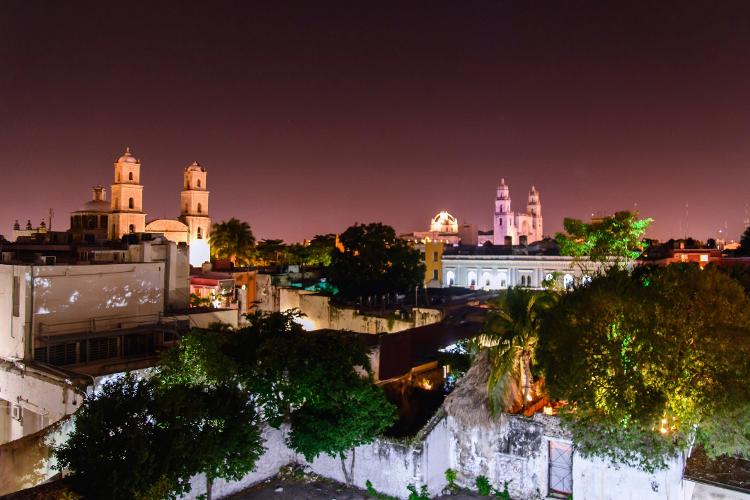The sky-blue sea with the white sand of the Mexican Caribbean must have been on your cell phone screen a few times on social media. Cancún, Playa del Carmen and Tulum have become obsessive destinations for Brazilians.
But on the same Mexican east coast, a little further into the Gulf of Mexico, there is a little-known (and explored) part of the Yucatan Peninsula that has attracted more and more tourists looking for a little more peace and quiet.

With more than 3,000 cenotes (underground deep water caves), a rich Mayan heritage in constructions and pyramids and an ancestral cuisine, the state of Yucatan has emerged as a destination in Mexico.
Also because, from wild beaches to the colonial architecture of Spanish arcades, from open-air markets to historical museums, there is much to discover in this authentic region, still preserved from a process of gentrification.

AGAINST GENTRIFICATION
The locals, by the way, do their best to keep it that way: that tourism is gradual, avoiding the massive model that took over the soft white sands not far from there. “We want people to come for the wealth we have, not what can be transformed,” says Michelle Fridman.
The project to create a train linking ancient Mayan paths, spearheaded by the federal government, has been rejected for this reason: residents are doubtful of the tourist impact it could bring to the region. There is fear of a “cancunization” process, as they say.

For now, they want to keep their interesting and unknown places as interesting and unknown. Until, at least, cities like Valladolid, an old colonial village with a cool atmosphere, become the new Tulum.
Until then, there is much to enjoy: the historic center of the city, with its Mayan soul and Spanish influence, still preserves the value of authentic handicrafts (such as those for sale at the Mercado de Artesanias), made by generations.
The Mayan huipil (the white cotton dress adorned with colorful embroidery and shaped like flowers that is the official attire of women) is in most stalls, as are small sculptures of religious figures and pyramids.

SACRED PYRAMIDS
This, by the way, is one of the main reasons to visit this Mexican region: the most famous is Kukulcán, in the archaeological site of Chichén Itzá, built in honor of the homonymous god represented by a feathered serpent.
In recent days, the pyramid has won the press and social networks when a tourist decided to climb one of its four steps, something prohibited by local authorities.
Not far from there, too, is the pyramid of the Soothsayer, in Uxmal, 40 meters high and inaugurated in 560 AD. The construction draws attention for its rounded shapes made with huge limestone stones carried without the help of animals.

ANCESTRAL GASTRONOMY
But the Mayan tradition goes far beyond the buildings: gastronomy is one of the values preserved until today. In the small Halachó, a village in the interior of the state, chef Wilson Alonzo opened Yaaxche, a restaurant and ethnogastronomic center.
More than serving typical recipes from his ancestors, such as cochinita pibil (pork marinated in achiote and cooked in a hole made in the ground) and xec (a fresh salad with fresh habanero oranges, coriander and zapote), he promotes workshops and classes for the interested.
“It’s a way of disseminating our recipes, while offering a more practical way for those who visit us to get to know our culture in depth”, he says.
Between cooking workshops and visits to markets, Alonzo wants to show the sophisticated cooking techniques of the Maya, such as cooking with hot stones.

“For a long time, it was thought that our kitchen was smaller. But my job here is to present all the richness of an ancestral population, which already cooked with many steps before being colonized.”
Gastronomy, by the way, is one of the biggest attractions of Yucatan: the state has just hosted the Latin American edition of the 50 Best, the most important award in the restaurant scene in the world. The idea is to grab tourists by the stomach.
COLONIAL CAPITAL
The celebration took place in Mérida, the most charming and interesting city in the region, with its colonial architecture, countryside atmosphere and beach resort atmosphere — even though the nearest beach, Progresso, is 40km away.
Mérida has a holiday atmosphere: bars and restaurants in the historic center are always full, wide and tree-lined streets, good shops and cafes. No wonder, it is the main choice as headquarters for those visiting the region.
The hotel structure — and real estate — does not stop growing. In addition to international chains, entrepreneurs have created more authentic hotels to attract an audience that seeks unique stays.

This is the case of Wayam Mundo Imperial, which tries to bring a bit of nature into the building with 52 suites. Taking advantage of the structure of a colonial palace, it is the first sustainable hotel with LEED certification in the city.
From yoga classes to a fresh and healthy cuisine restaurant (Cuna), it is a good option for those who want to enjoy the city on foot. 30 minutes away, however, are the most coveted rooms in the region.
LUXURY AND INTEGRATION

The Chablé is a kind of luxury natural resort in Chocholá, a village that was built where an asteroid fell more than 65 million years ago. Lauded for the natural sage that grew there, the hotel is an immersion in the Mayan soul.
Due to its ability to integrate elements of nature with a bold and sustainable architecture, the hotel won the prize for accommodation with the best architecture in the world in 2017, by the Prix Versailles — awarded by Unesco.
Each of the 38 rooms has its own pool and the SPA uses a natural cenote as a water source. All built to preserve nature as much as possible, integrating tourism with the surroundings. A goal pursued in Yucatán, at least as long as possible.

With information from UOL

